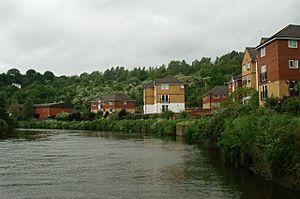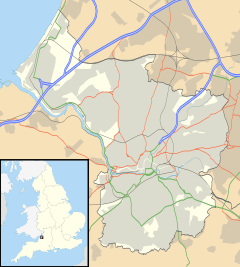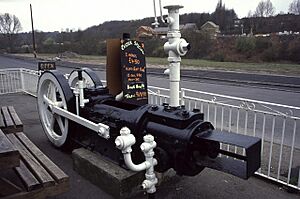Crew's Hole, Bristol facts for kids
Quick facts for kids Crew's Hole |
|
|---|---|
 Quayside Village now occupies the site of the former tar works at Crew's Hole. |
|
| OS grid reference | ST625735 |
| Unitary authority | |
| Region | |
| Country | England |
| Sovereign state | United Kingdom |
| Post town | BRISTOL |
| Postcode district | BS5 |
| Dialling code | 0117 |
| Police | Avon and Somerset |
| Fire | Avon |
| Ambulance | Great Western |
| EU Parliament | South West England |
| UK Parliament |
|
Crew's Hole is a small area in east Bristol, England. It sits right next to the River Avon, about two miles upstream from Bristol Bridge. For a long time, Crew's Hole was a busy industrial place, known for making different products. Today, it's a mix of old history and new developments.
Contents
A Hub for Industry: Crew's Hole's Past
Starting in the early 1700s, Crew's Hole became a very busy place for factories and workshops. In 1810, the Bristol Brass Company started melting copper here. They even built a tall chimney uphill to help their furnaces work better.
A pottery factory opened in 1812, started by Anthony Ammatt. This factory used special clay brought all the way from the Isle of Wight and Poole. During the 1800s, several places that built barges (flat-bottomed boats) were also set up here.
The Famous Tar Works
A large tar works was built in 1843 at the bottom of Troopers Hill. It was started by the famous engineer Isambard Kingdom Brunel. This factory had a very distinctive chimney.
The tar works made creosote, which is a special oil used to protect wooden railway sleepers (the blocks that support railway tracks). By 1863, Brunel's manager, William Butler, owned the works.
Making Roads and More
Around the year 1900, the factory started making tarmac for roads. This soon became its main product. In 1970, the British Steel Corporation (BSC) took over the tar works. Under their ownership, it became one of the most modern factories in Europe.
It could produce creosote, road tar, and smokeless fuel 24 hours a day, seven days a week. The tar works kept running until 1981. By then, it had stopped making road tar and mainly focused on distilling (cleaning) other products. After it closed, the area was empty for some years. Then, in 1989, it was redeveloped into a new area called Quayside Village.
Flooding in Crew's Hole
Because Crew's Hole is right next to the River Avon, the area has sometimes experienced flooding. Big floods were recorded in 1894, 1960, and 1968.
Images for kids




